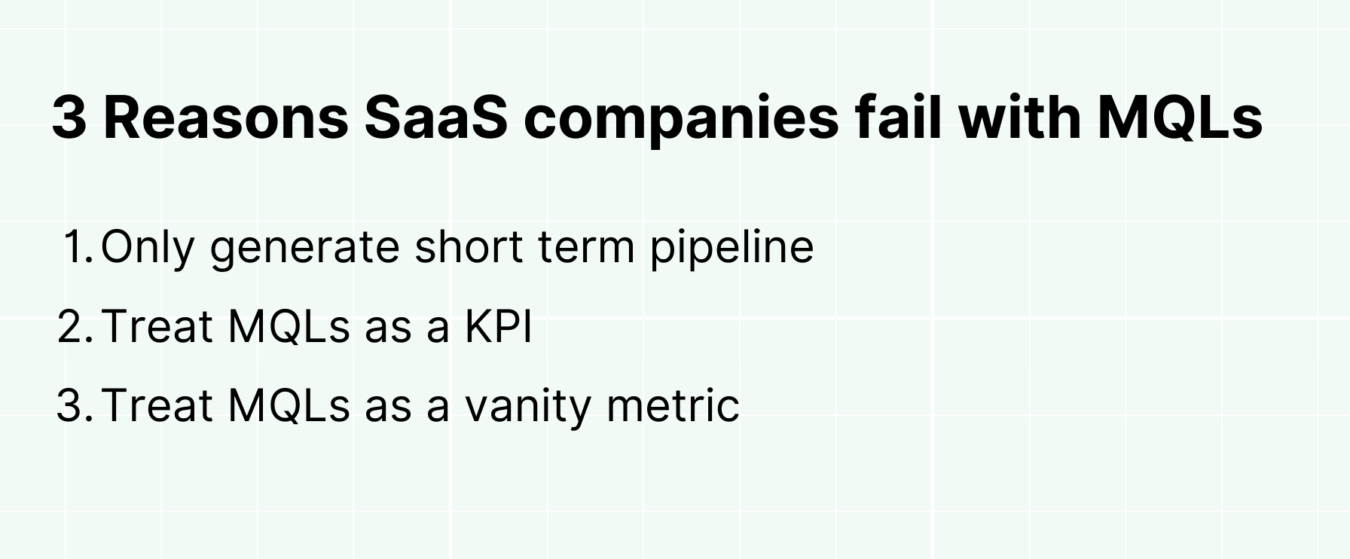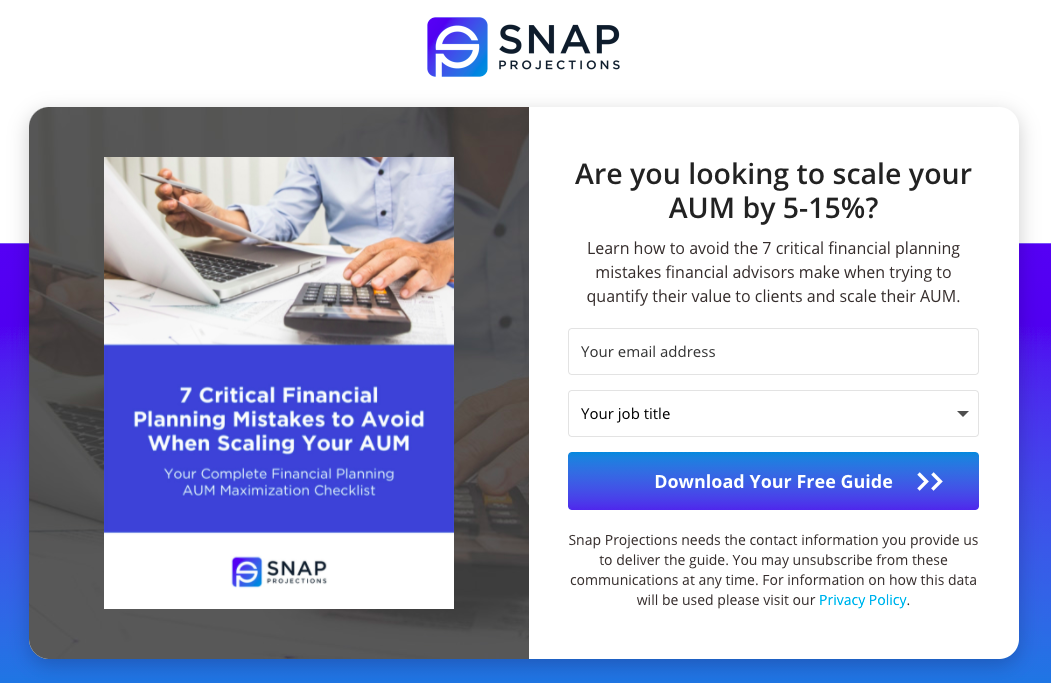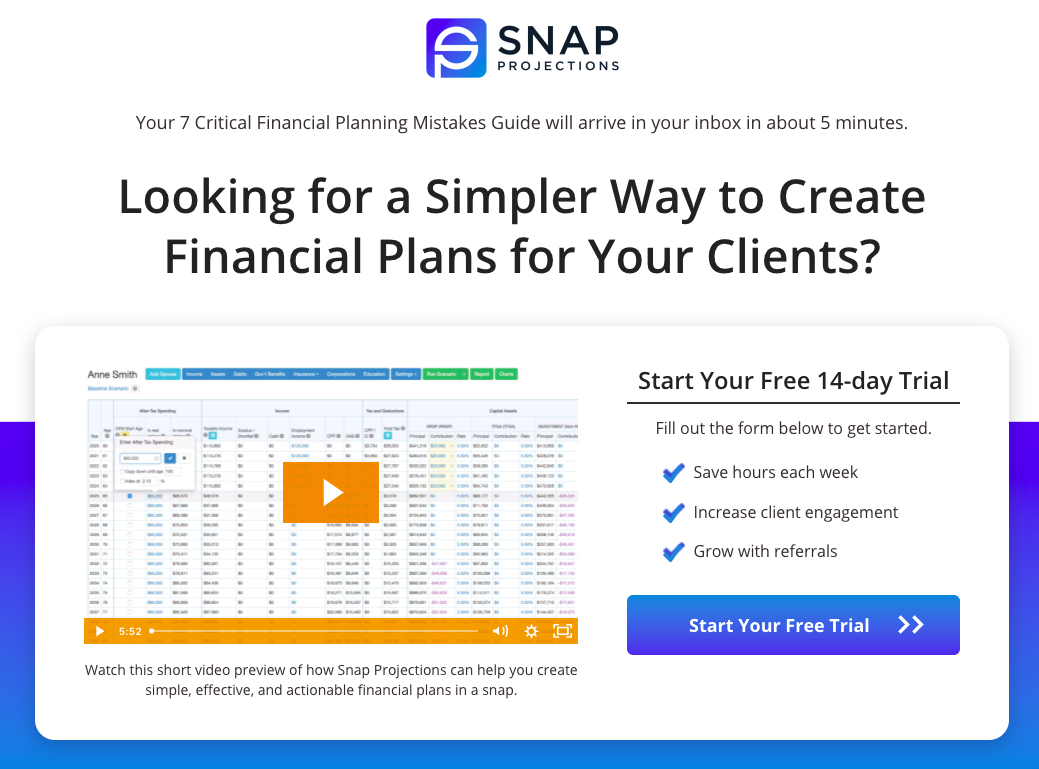The MQL isn’t dead, you’re just using them wrong (and how to turn them into customers)
Last updated: December 12th, 2023
People say that the MQL is dead.
Most B2B SaaS companies have a process for collecting and defining marketing qualified leads (MQLs). But we often talk with SaaS companies who haven’t got a process for turning those Marketing Qualified Leads (MQLs) into trials and demos.
The result is that they see capturing MQLs as a low-value activity. They stop making efforts to nurture prospects who aren’t ready to buy.
This can lead to a number of significant business challenges, including problems filling the pipeline in future quarters, missing growth targets, and losing market share to competitors.
In this article, we’ll look at:
- Why MQLs are still a valuable part of the customer lifecycle
- Where SaaS companies go wrong in capturing MQLs
- How we’ve helped our clients to build valuable demand gen systems using MQLs
After reading this post, you’ll have a solid understanding of how to think about generating MQLs in a way that helps you grow instead of simply meeting vanity targets.
Want to generate a reliable trial and demo pipeline for your B2B SaaS? Schedule a Get your Free Marketing Plan today to learn how we can help you generate MQLs and SQLs that turn into customers.
The evolution of the MQL
MQLs are now seen as an artifact of the marketing process rather than a stage in the buyer’s journey – but, they are more than that.
But the MQL stage is critical, sitting at the intersection of the stage in the buying process where potential customers know you and like you.
Many companies fail to see the benefits of the MQL in the customer lifecycle because they cannot see it as a part of a bigger picture. Even marketers often miss out on the value of MQLs and lose out on qualified prospects as a result.
Successful B2B SaaS companies control as many touch points as possible and give accurate, helpful information to help buyers decide whether they go with you or with a competitor.
By not making the most of MQLs, companies fail to nurture their prospects, which brings in unqualified leads and places unnecessary pressure on the sales team.
Let’s dive into the most common reasons companies struggle to make the most of their MQLs.
Why SaaS companies fail to capture MQLs effectively
MQLs can be a useful part of your customer lifecycle, but only if you know how to use them effectively.
Although their value is well known, there are many reasons that SaaS companies fail to nurture and capture the buyer at this stage.
A reason for this could simply be a failure to see MQLs as part of the bigger picture, or that many marketers know their inherent value but are so focused on bottom of funnel prospects, that they don’t want to invest in educating or motivating the prospect, creating a low quality pipeline of leads.
This is just the tip of the iceberg.
Let’s take a closer look at the main reasons for these failures:

Seeing MQLs as a vanity metric
A narrative emerging in modern marketing and demand gen suggests avoiding MQL collection altogether in favour of using data enrichment tools (such as Cognizant, ZoomInfo, and Clearbit, etc.). In this case, companies reach out to customers that fit a specific profile vs. leading them to a page to fill out a form.
While this approach can reduce up-front friction the prospect has not permitted you to contact them. You could risk alienation and sow distrust taking this route.
Disregarding an MQL is a seller-centric point of view, taking the emphasis off the customer or buyer, and focusing on the easiest route for the marketer or sales person. This can be a real miss on the part of the company.
Whether you know it or not, sales-qualified leads were in the marketing-qualified lead awareness stage at some point, but may have been operating as anonymous users.
By putting effort and thought into your MQL to trial/demo flow, you can guide these anonymous prospects along the process and guarantee higher opt-in and conversion rates.
Thinking only in the short term
Nurturing prospects through the MQL stage may take longer, but it creates a more reliable pipeline of good-fit customers in the long term.
Teams focused solely on SQL or revenue based targets only try to convert the prospects who are ready to buy.
The MQL stage is important for prospects because it allows them to raise their hands in order to identify themselves (with permission) and receive personalized, relevant information to help guide them on their buying journey.
This builds trust and value in the customer-company relationship early on and helps them to see your product as a valuable solution to their problems when they’re ready to buy.
This is often why the hard work in educating and motivating a prospect is neglected or seen as ineffective.
Seeing MQLs as a KPI
Companies want leads but, when you look at MQLs as a KPI, it becomes a numbers game where quantity trumps quality.
For many marketing teams, getting someone to fill out a lead gen form indicates they fit a particular Ideal Customer Profile (ICP), but it doesn’t matter if they convert or convert and eventually churn.
They focus on “I got this number of people to download an ebook, my work is done – now it’s a sales problem.”
This can damage or hinder a company’s growth.
Instead of following trends and developing content that mimics other companies, content marketing teams should learn about their customer’s specific needs and address those needs accordingly.
How we helped our client use MQLs to increase conversion and opt-in rates
Let’s look at how we helped one client find a way to optimize their nurture sequence.
As a player in a crowded financial planning space, our client, Snap Projections, was up against a long-standing competitor that had significant market share. Despite the competitor being around longer, we knew our client could stand out through optimizing the customer lifecycle process.
To optimize their MQL to SQL deal flow, we identified ways to reduce friction, introduce behavioural psychology and make their content compelling and actionable.
The result? Snap Projections found more value in their MQLs and increased opt-in rates significantly. Thanks to our methodology and tactics, we see higher than industry standard rates when working with clients to improve their MQL to trial flow.
The industry benchmark rate for opt-in forms is 1-5%, but using our method, our clients see the rate of leads entering the funnel increase to 15-30%.
When it comes to MQLs, our view is contrary:
We see them as a valuable and necessary step in the buying process and vital to a company’s long-term growth.
How to build a valuable demand gen system using MQLs
We’ve just looked at the common errors that SaaS companies make when thinking about MQLs.
Now let’s take a look at the strategy we use to help SaaS companies build a solid pipeline of prospects using the MQL stage.
Understanding which stage your buyer is at
A mistake that many B2B SaaS companies make is putting all of their time and energy into SQLs.
The customer has an entire process they will go through before they ever buy anything from you. Increase the likelihood of a sale by showing your customers you understand what their needs are at each step and helping them develop their own understanding of how to solve their problem.
Producing the right content for the right stage is one of the most effective ways to make the most of your MQLs.
Examples of the types of lead magnets that we have found to work well in B2B SaaS include:
- Problem unaware content – Books, quizzes, symptom-focused articles, press articles, category consumption (content that goes through the why, what, how, and what to do next regarding your product category)
Problem aware content – Checklists, webinars, guides, templates - Solution aware content – Calculators, buying Guides, industry Reports, product choice quizzes, scorecards
- Product aware content –Case studies, comparison pages, use case pages, ROI calculators
We developed our Buyer Awareness Matrix as a way to show what type of content we share at specific stages, helping move prospects to the next level of awareness.
Serving the right content at the right time can increase your chances of giving your audience what they need to move through to the next stage.
Build offerings that are compelling and actionable
SaaS companies often create content that is complex, unactionable, hard to consume, and not aligned with the prospect’s goals.
Worse, it’s often developed to keep up with the Joneses. Your competitor puts out a 30-page ebook so you think you should, too.
Or you spend time and resources producing a webinar, but it’s not very compelling for the buyer.
To really drive growth, SaaS companies should think about creating content that is SAGE:
- Simple
- Actionable
- Goal‑oriented
- Easy to consume.
To effectively engage a prospect to move from MQL to trial or demo, you must identify problems felt by customers and offer solutions.
Try to figure out what their problem was, reflect or frame it back to them.
As mentioned earlier, the Buyer Awareness Matrix will help you identify what type of content to produce at which stage. Doing so makes your lead magnet content compelling, actionable, timely, and improves deal flow.

Give prospects a chance to ‘choose their own adventure’ by offering options on how they would like to engage with your brand.
Many SaaS companies develop long, dense white papers for download when they should offer their prospects a quicker, more actionable report.
The correct type of content is the one that solves the prospect’s question and moves them further along the buyer awareness process.
In the case of Snap Projections, who we mentioned above, competitors had lead magnets that were useful but were too bulky, and not easily consumable.
By offering a one-page report that spoke precisely to the audience’s needs, we helped Snap Projections make their offerings more client-centric.
Connect landing page copy to customer awareness
Once we understand what stage of awareness the prospect is currently at, we optimize landing pages to speak directly to them.
Aim for a friction-free flow by keeping your forms and copy tight. Ask only for information that is necessary.
As we mentioned earlier, with Snap Projections, our research helped us identify that the target buyer was a problem aware buyer who is not yet aware of a better solution (the client’s solution).
Our approach was to develop a product choice guide to increase solution awareness. The ebook that we produced addressed the question: “How are the common problems experienced by a person at this stage of the buying process solved by using a product like Snap Projections?”
On the client’s lead magnet landing page, prospects are offered a short guide on 7 critical mistakes to avoid.
Growing their assets under management (AUM) is vital for financial advisors. Snap Projections helps them achieve higher AUMs by simplifying the financial planning process, increasing client engagement, and growing through referrals.
Snap Projections also solves the problem of retention and scaling for financial advisors. With that in mind, we created a lead magnet that centered on this topic.
Tapping into the attention, intent, desire and action (AIDA) framework, we wrote more compelling copy to our landing pages.
We tailored our copy to the audience’s exact problem, positioned our offering as a solution and found ways to encourage action based on desire embedded in the CTA.
We kept the growth amount both reasonable and achievable to encourage downloads, asking: “are you looking to scale your Assets Under Management (AUM) by 5-15%?”

Optimize the lead magnet download thank you page
Typically, the lead magnet download thank you page is overlooked.
This page is an underappreciated opportunity to move people along in the funnel and provide them with more info at the time of interest to increase conversions.
There are two big overlooked opportunities:
- Add visitors to these pages to remarketing audiences
- Move visitors down the funnel
Firstly, we use the Boomerang Method.
Not everyone will convert on their first visit to your site or after downloading a lead magnet. However, by pixelling them on this page, you will be able to add them to remarketing audiences on social advertising platforms like Facebook and LinkedIn.
This will allow you to nurture the MQL even if they stop looking at your website. You will find that a portion of MQLs who are remarketed will return and qualify themselves further.
Secondly, move prospects down the funnel by offering MQLs additional ways to engage.
For example, we offered people who downloaded the lead magnet for Snap Projections a way to choose their own speed – in this case, start a free trial.

By using lead magnet thank you pages to provide these prospects with a contextualized offer, we helped our client convert MQLs to SQLs at a rate of 5% to 10%.
In closing
MQLs being seen as a vanity metric or inefficient is why many B2B SaaS companies are not seeing their value.
By implementing several strategies including optimizing the thank you page, developing compelling and actionable content, reducing friction through the process, and having multiple pathways to engage, marketing teams can get the most out of their MQLs.
Effectively using MQLs helps SaaS companies build a quality pipeline, hit growth targets, and stay ahead of their competitors.
Putting the ideas from this article into action will help ensure that you convert more MQLs into quality prospects making your sales process run easier and your company scale more effectively.
Get your Free Marketing Plan today and we’ll show you how to confidently turn more MQLs into Customers for your B2B SaaS.
What you should do now
Whenever you’re ready…here are 4 ways we can help you grow your B2B software or technology business:
- Claim your Free Marketing Plan. If you’d like to work with us to turn your website into your best demo and trial acquisition platform, claim your FREE Marketing Plan. One of our growth experts will understand your current demand generation situation, and then suggest practical digital marketing strategies to hit your pipeline targets with certainty and predictability.
- If you’d like to learn the exact demand strategies we use for free, go to our blog or visit our resources section, where you can download guides, calculators, and templates we use for our most successful clients.
- If you’d like to work with other experts on our team or learn why we have off the charts team member satisfaction score, then see our Careers page.
- If you know another marketer who’d enjoy reading this page, share it with them via email, Linkedin, Twitter, or Facebook.
